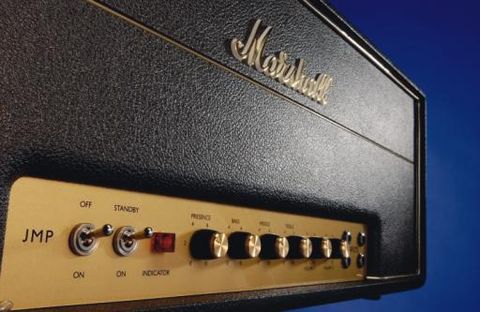Marshall's 1959 'Plexi' is arguably the most famous amp of all time. A Super Lead 100 sat atop two 4 x 12 Celestion-loaded cabs is still for many players the definitive rock guitar rig. Hendrix, Clapton, Beck, Page and Van Halen, to name just a few, have all created history with this amp, recording some of the most influential tracks ever.
The 'Plexi' is now available in the original format that was used for only a few years before Marshall switched to PCB manufacture, turning the handwired 'Plexi' into the holy grail of guitar amplifiers.
Cosmetically, this is as close as you can get to an original with a stout plywood cabinet with the correct dimensions and covered with the earlier small-grain vinyl. Other details, like the smaller gold-faced logo and gold-painted Plexiglas control panels (which gave this model its nickname) are spot-on too.
A lot of mythology, often from dealers looking to jack up the price, has grown up around this amplifier. However, underneath the skin, the 1959 is a simple circuit with roughly 60 small components on a neatly-wired circuit board, with the filter caps sitting on top of a steel, rather than aluminium, chassis.
Marshall has gone to great trouble to ensure the components are as correct as possible, with the all important transformers and choke made by Dagnall to the earlier C1998 specification. The standard of wiring and soldering is exceptionally high, with neat lacing around the main bundles of cable and twisted heater leads pushed into the chassis corner to reduce hum.
Design
The control panel consists of four input jacks feeding two parallel preamp stages, one voiced brighter than the other, with separate volume knobs, a shared three-band EQ and a presence control. No master volumes here, and no channel switching - this is a simple brute of an amplifier, but that's the secret behind its monstrous tonal power.
It's worth pointing out that amps from this period were very much 'works in progress'. They experienced numerous component changes, sometimes because of a change in design or supplier, other times purely for expedience - for example, changing to the nearest value when stocks of a certain capacitor ran out in order to keep production going.
This explains why these early amps varied so much in tone. However, much time has been taken to ensure the new Hand-Wired version is more consistent. "For this amp we eventually narrowed our listening tests down to two original heads with slightly different characteristics that we felt exemplified the 'Plexi' sound - the reissue incorporates the best features of each," explains Marshall R&D tone guru Danny Thomas. "One of those heads was only about 60 serial numbers away from the amps Hendrix took to Woodstock - so you can't get much closer than that!"
In use
We set up our own listening test, alongside a late sixties 1959 which was restored a few years ago and an earlier version with the filter caps contained inside the chassis. The new amp excels with greater headroom, less noise and a darker, less aggressive treble that makes soloing a sheer unadulterated pleasure, even using a Strat's bridge pickup.
"The original circuit actually continued beyond the Plexiglas panel versions," commented Thomas, "so there are metal-faced 1959s electrically identical to the 'Plexi' - and they sound just as good.
"There was a transformer change around 1971 that did make a difference: the lamination specs changed from standard to high quality - the reason is lost in the mists of time - and that gave the amp a harder, more aggressive edge, similar to our SLP reissue.
"The Hand-Wired 1959 uses the earlier, lo-fi transformer spec which gives the definitive, darker, early 'Plexi' tone. Those very early versions with the filter caps inside the chassis tend to be the ones with higher noise levels as the transformers were closer together. The new model has the wider transformer spacing and we're very pleased with the headroom and noise performance."
The 1959's brutal power and endless headroom is perfectly suited to big arenas and outdoor festivals. However, you can tame it for smaller venues. Using a small jumper lead to combine both channels is the secret for real 'Plexi' tone. With this plugged in, you get a thicker sound which can be fine-tuned by balancing one volume control against the other.
An attenuator such as the THD Hot Plate means you can wind those volume controls up to get the output valves working properly, while a small amount of extra front-end gain from a good overdrive pedal helps push the preamp.
Just a few minutes' work can create some frighteningly accurate Hendrix sounds from a Japanese reissue Strat. Switch to a Les Paul, and every classic riff played on this combination is unbelievably pure. From Cream-era Clapton through to AC/DC; it's almost unreal to hear such great sounds coming from such a simple circuit.
Old amplifiers don't age gracefully; they usually need a lot of work to make them useable and safe. So buying an original is for those who want to make an investment, not music, and there's no doubt that Marshall's recreation of its original flagship is the real deal. You don't buy an amp like this for versatility or portability, but for sound. And the Hand-Wired 1959 has it exactly right.


